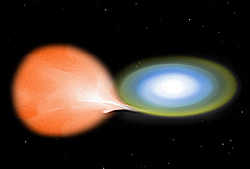 |
| "Making a Nova" by NASA/CXC/M.Weiss Licensed under Public Domain via Commons |
Nova
A nova is a cataclysmic nuclear explosion on a white dwarf, which causes a sudden brightening of the star. Novae are not to be confused with other brightening phenomena such as supernovae or luminous red novae.
Novae are thought to occur on the surface of a white dwarf in a binary system when they are sufficiently near to one another, allowing material (mostly hydrogen) to be pulled from the companion star's surface onto the white dwarf. The nova is the result of the rapid fusion of the accreted hydrogen on the surface of the star, commencing a runaway fusion reaction.
Wikipedia
White dwarf
 |
| Image of Sirius A and Sirius B taken by the Hubble Space Telescope "Sirius A and B Hubble photo.editted" by Bokus Licensed under Public Domain via Commons |
A white dwarf, also called a degenerate dwarf, is a stellar remnant composed mostly of electron-degenerate matter.
A white dwarf is very dense: its mass is comparable to that of the Sun, and its volume is comparable to that of Earth.
A white dwarf's faint luminosity comes from the emission of stored thermal energy.
The nearest known white dwarf is Sirius B, at 8.6 light years, the smaller component of the Sirius binary star.
There are currently thought to be eight white dwarfs among the hundred star systems nearest the Sun.
The unusual faintness of white dwarfs was first recognized in 1910. The name white dwarf was coined by Dutch-American astronomer Willem Luyten (1899 – 1994) in 1922.
White dwarfs are thought to be the final evolutionary state of stars (including our Sun) whose mass is not high enough to become a neutron star—over 97% of the stars in the Milky Way.
After the hydrogen–fusing period of a main-sequence star of low or medium mass ends, a star will expand to a red giant during which it fuses helium to carbon and oxygen in its core by the triple-alpha process.
If a red giant has insufficient mass to generate the core temperatures required to fuse carbon, around 1 billion K, an inert mass of carbon and oxygen will build up at its center. After shedding its outer layers to form a planetary nebula, it will leave behind this core, which forms the remnant white dwarf.
Wikipedia
No comments:
Post a Comment